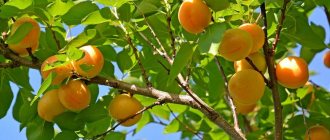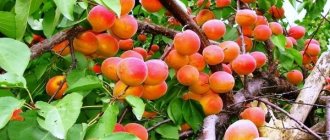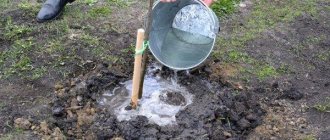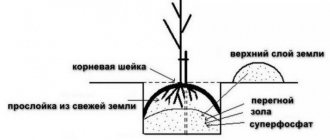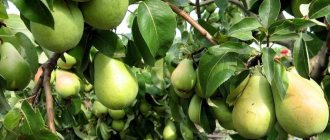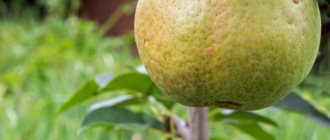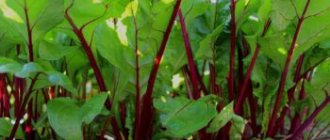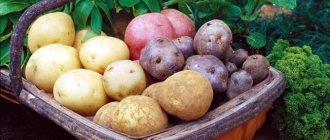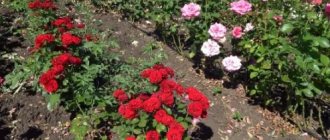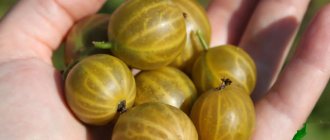Apricot Lel: variety description
Apricot Lel was obtained back in 1986 by employees of the Botanical Garden Skvortsov and Kramarenko. It was the result of long-term work, when the seedling was obtained through the process of natural mutation (as a result of free-type pollination).
It became officially recognized only in 2004. Until that time, it had already established itself well among gardeners.
Apricot Lel - photo
Geography of cultivation
There are recommendations for growing this apricot in central Russia, including the Moscow region. However, this does not prevent it from being planted in Siberian, Far Eastern, and Ural territories and receiving a high and high-quality harvest.
The only difference in caring for the Lel apricot is the need for shelter for the winter.
Appearance
The Lel apricot tree can reach a height of 3 meters. The crown is neat and fairly well leafy. The shoots develop slowly, and therefore strong branching is not observed. This greatly facilitates the care of Lel apricots in terms of pruning, harvesting, and preventive treatment.
Photo of strawberry Evis Delight
Leaves
The leaves are ellipsoidal in shape, which is facilitated by a sharp narrowing from the base to the tip of the leaf. The edges are in the form of teeth. The outer surface of the leaf blade has a bright, juicy green color. The inner surface or the reverse side looks faded and is covered with very short fibers.
In autumn, the color of the foliage changes from the usual green to a red hue.
Features of cultivation and subtleties of care
After planting, the seedling is pruned. To do this, choose the strongest shoots directed in different directions. The optimal angle of branches from the trunk for the formation of a small-sized crown is 45–50°. Cut the side shoots to the outer bud so that they are approximately 1/3 shorter than the central conductor. In subsequent years, they maintain the layering of the crown and try to prevent it from thickening.
When pruning, remove:
- Crossing branches.
- Shoots directed inside the crown, towards the trunk.
- Shoots looking down.
- Thickening and weak branches.
- Basal shoots.
To the delight of summer residents, the Lel apricot is characterized by slow growth and does not require constant attention. In order for trees to better withstand winter frosts, summer formative pruning is recommended. In this case, only strong shoots 50 cm long are left, the rest are cut into a ring. And in August, they select a powerful young shoot, bend it towards better lighting and tie it with twine until next year.
Scheme of apricot crown formation
Another important measure for protecting trees is whitewashing. It is carried out in late autumn and early spring, ensuring protection of the bark from winter frosts and recurrent spring frosts. It is recommended to add copper preparations to whitewash to prevent fungal diseases. Both the tree trunk and the main skeletal shoots need to be whitened.
Recent Entries
5 working ways to use tar in the garden 7 indoor plants that help you get married even in adulthood Indoor plants that can bloom in trouble
In general, the Lel apricot is a winter-hardy variety and can easily tolerate cold temperatures down to 25–30°C. There is no need to cover trees in winter. If, nevertheless, frost damage has damaged the bark, then in the spring in April-May, the injured area is cleaned to healthy tissue and covered with garden varnish.
To obtain a stable and good harvest of apricots, it is recommended to plant at least two trees. The more planted, the more effective the pollination.
Recommendations for caring for the Lel apricot are similar to those for other northern apricots.
Video about growing winter-hardy apricots
Winter hardiness of Lel apricot and its drought resistance
Apricots are known as a crop that is very responsive to heat. However, Lel is frost-resistant. In addition, it can develop during prolonged drought. Therefore, this is the most suitable option for areas with harsh climates.
In spring, when there are frosts at night down to -1, -3 degrees, it does not require additional shelter
. This does not in any way affect his fertility. In the fall, of course, it needs to be prepared for winter. With proper preparation, it is perfectly preserved and can withstand temperatures down to -30 degrees.
Flowering and pollinating trees for apricot Lel
Lel has the highest self-fertility
. Flowering occurs in May. This is a very beautiful period when the tree looks decorative, thanks to the many small flowers of delicate pastel pink tones. The diameter of the flower does not exceed 3 cm. There are both stamens and pistils. It is for this reason that the process of self-pollination is possible.
Apricot varieties!
Apricot Royal Apricot Northern Triumph
The plant contains flowers that require cross-pollination. To increase the amount of harvest, place 2 - 3 trees close to each other. Worthy pollinating varieties for apricot Lel - Aquarius or Alyosha
. It's not obligatory. If these varieties are missing, Lel will bear fruit on its own, only a little worse.
Attention!
The Lel apricot requires neither bumblebees nor bees.
Characteristics of the variety
According to its description with photos and reviews from gardeners, the Lel apricot variety deserves maximum ratings in many respects. The peculiarity of this variety is the ability to adapt to unfavorable climate, high yield and excellent taste of the fruit.
Winter hardiness and drought resistance
Heat-loving apricots tolerate long-term lack of moisture well. An additional advantage of the Lel variety is resistance to cold. With proper shelter in the fall, even young seedlings can withstand winter temperatures dropping to -30 degrees. This apricot is not afraid of spring night frosts from -1 to -3 degrees. Therefore, the Lel variety is grown in the Moscow region and in regions with cold climates. It is one of the regularly fruiting varieties.
Flowering and pollination characteristics
This variety of heat-loving crop is self-fertile. The flowering period begins in May. Then many small pastel pink flowers with a diameter of up to 3 cm appear on the branches. They have stamens and pistil covered with pollen. Therefore, self-pollination is possible for this variety.
There are also flowers on the tree that need cross-pollination. To increase productivity, 2-3 trees are planted nearby on the site. The Alyosha or Aquarius varieties will be good pollinators for these apricots. But if there is no free space on the site for planting several apricots, then Lel will bear fruit on her own. But the harvest will then be smaller.
On a note! This fruit tree does not require bees or bumblebees to pollinate. Flowering begins in May, when these insects show little activity.
The Lel variety is early. Despite this, frosts rarely bother it during the flowering period. Therefore, in the northern regions, the Lel apricot, provided proper care, produces good yields. The fruits of the apricot tree ripen in the second half of July.
Features of fruiting and productivity
The tree begins to bear fruit 3 or 4 years after planting in open ground. Ovaries are formed on flowers collected in clusters or on single flowers.
During ripening, small fruits are formed, the weight of which is up to 20 g. The only drawback of the Lel variety is the small size of the fruits. But the taste is superior to other varieties with larger apricots. They have a regular, symmetrical shape, slightly flattened on both sides. Their skin is smooth, without pubescence. In the sun's rays, a glossy shine is visible on the skin.
Apricots with dense and elastic, but rich in juice pulp of a bright orange hue. Blush on the skin rarely appears, even in places where the sun's rays fall on the fruit. Inside the fruit there is a large stone with a sweet kernel.
The pulp has a sweet, slightly sour, pleasant taste. Professional tasters rated it the highest. This is an excellent indicator. After all, many varieties from the south of the country did not receive such praise.
The scope of application of Lel apricots is universal. These fruits are eaten fresh, canned, dried, and used to make jam or compote. The fruits contain many useful substances, so baby puree is made from them.
Peculiarities of fruiting and yield of Lel apricot litter
The tree bears fruit at the age of 3–4 years from the time of planting in a permanent place of growth. In this case, ovaries are formed both on clusters and on individual flowers.
The apricots themselves are small in size. The weight of one Lel apricot fruit is no more than 20 grams
. Perhaps this is the only relative disadvantage of the Lel variety, which is definitely outweighed by its high taste characteristics in comparison with those varieties whose fruit size is larger.
The fruits look aesthetically pleasing, with a regular, symmetrical shape. Slightly flattened on both sides. The peel is smooth, there is no pubescence. When sunlight hits the surface of the fruit, you can notice a glossy shine.
Apricot pulp is dense, elastic, and has a “delicious” orange color. Sometimes, in rare cases, you can notice the presence of blush. The bone inside is small. The nucleolus has a sweet taste.
The pulp is sweet with a slight sourness. The most fastidious gourmets gave the Lel apricot a high score.
Apricot resistance to diseases and pests
Lel has an average degree of resistance, in particular, to a disease such as clasterosporiasis. To eliminate the disease, spray with Bordeaux mixture. Nitrafen has also proven itself well. It is important to carry out the procedure before the sap flows and leaves fall off.
Aphids rarely attack this crop. Signs of the presence of insects are curled leaves and the presence of black dots. To eliminate uninvited guests, an infusion of onion or garlic is used, and they are also dusted with tree resin.
Attention!
Lel requires frequent preventative care because she does not have high immunity.
Leafworms can cause a lot of damage. The tree is vulnerable to them throughout the year. To protect the tree, the trunks are whitewashed. Lime protects the tree bark from damage by insects. When whitewashing is not effective, treatment is carried out with nitrafen (2%), making a solution. The suitable period for processing Lel apricot trees is autumn.
The codling moth may appear in the summer. Caterpillars feed on greens and fruits. They can eat up to half of all fruits. To combat them, biological products Fitoverm and Lepidocid are used. Among the “folk methods” they use an infusion made from tobacco leaves, as well as a decoction of wormwood.
Advantages and disadvantages
The variety has its advantages and disadvantages. You need to know them before growing the variety in your garden plot.
Advantages of the Lel apricot variety:
- early ripening;
- resistance to low temperatures;
- compactness of the tree;
- long-term storage of fresh fruits;
- high taste qualities of Lel apricots.
Flaws:
- small fruit size;
- the bone takes up a lot of space inside.
Harvesting and storage
The ripening of the Lel apricot crop occurs gradually. Therefore, collection must be carried out in stages over 30-40 days.
The collected fruits can be stored fresh in a cool room at a temperature of +4 degrees and a humidity of 80% for 2 weeks. In the future, they will soften and rot. Natural losses during storage of 3-4 weeks are about 20%.
Apricot Lel is a variety with a unique fruit taste that shows good performance in the central regions of the country. Many gardeners also prefer it for its moderate crown growth, which makes it easy to care for and harvest the crop.
Apricot Lel: agricultural cultivation technology
The variety has its own characteristics of planting and growing.
Landing rules
Lel apricot seedlings are planted only after the juice flows
. In the central zone, this is approximately the middle of April, on the 15th - 16th. At night the temperature should not be lower than + 10 degrees. Compliance with these conditions will allow the creation of a strong and powerful root system for winter, which will help to survive the most severe frosts.
Planting apricots in a simple way.
It is possible to plant seedlings of the Lel variety in the fall
. Here you need to choose the right time: at least a couple of months before the onset of cold weather. If you are late with planting, this may lead to the death of the apricot seedling.
Landing site requirements
Since apricots love warmth, they are planted in areas well lit by the sun and protected from drafts. The soil needs to be light and airy, with adequate drainage. The most comfortable environment is black soil, sandy loam, loamy soil.
Interesting!
The best varieties of cherries for Siberia
One-year and two-year-old seedlings are suitable for planting. The main condition is a well-developed root system, white or cream in color. The bark should be examined. It should be smooth, with no damage, cracks, or rot. The color of healthy wood is light green.
Attention: it is necessary to purchase a seedling with the presence of an influx. This is an indicator of the vaccination site. Its absence indicates that this plant is wild. Another sign of wildness is the presence of thorns.
Lel apricot planting algorithm
7 days before the intended planting, a hole is made. Its depth is approximately 70 cm. There is good drainage, as well as enriched soil together with humus. Apply 1 liter of wood ash as top dressing.
In order for the Lel apricot seedling to take root faster, leave it in a solution for a day in a growth stimulator
. After this, carefully examine the roots, cutting off those shoots that are damaged. Other roots are shortened to a length of 2 to 3 cm.
Immediately before placement in the ground, the root system is dipped in a clay solution and then left to dry for some time.
A peg is placed in the mound that has formed at the bottom of the planting hole so that it is at least 20 cm longer than the seedling itself.
The seedling is placed in the planting hole and the root system is carefully straightened. The tree is sprinkled with soil so that the neck of the root rises 5 cm above the soil surface.
The soil is properly compacted, after which a significant amount of water is added. It is required that the water be absorbed, after which the area around the trunk is mulched.
The seedling needs to be protected from sunlight for a couple of days by placing a screen
.
Aftercare for apricot Lel
To get a good harvest, it is worth creating suitable conditions. Apricots of the Lel variety cannot be called very whimsical. No special care procedures are required at all.
How to properly water apricot Lel
Apricots don't like too much water.
. In this regard, it is important to maintain moderate watering. It must be systematic. After all, lack of water can also affect the quality of apricots. They may be of insufficient size and fall off quickly after ripening. At the same time, the pulp begins to dry out and lose its taste. Productivity suffers.
When do we start watering the trees?
It is recommended to water Lel apricots by sprinkling.
Advice!
The plant has roots on the surface, so there is no need to pour water directly under them. This will lead to washing out of the soil and drying out of the root system.
There is another irrigation option, which involves making a ditch no more than 20 cm deep. To make a ditch you will need to step back about half a meter from the tree trunk. After this, an additional 2 to 3 grooves are made, keeping a distance between them, first 50 cm from the trunk and then after 30 cm. It is in them that watering is carried out. Take 50 liters of water per plant.
How often to water an apricot depends on the weather
. Be sure to irrigate during the growing season and fruit set. As a rule, a month before they are fully formed. After this, watering is reduced. This will help preserve the fruits in proper condition without compromising their quality or taste.
When autumn is dry, watering is carried out, which will help prepare the trees for winter. For moisture-charging irrigation, take 70 liters of water.
Feeding apricot trees of the Lel variety
In spring, fertilizers with nitrogen are applied
. You can use products with completely different contents of this substance. The procedure is carried out in accordance with the instructions. The first application of fertilizers is carried out on April 15-16. Next, feed the Lel apricot before and after flowering. After this, potassium and phosphorus are added.
Attention:
Every 2–3 years humus is added to the soil. On a tree, 2 to 3 buckets are enough. Natural fertilizers are good in the process of fruit formation. They are replaced with industrial fertilizers based on vermicompost.
30 days after picking ripe fruits, fertilizers containing potassium and phosphorus are used. Superphosphate – 50 g and potassium sulfate – 30 g are used. Ash is an excellent substitute on an exclusively natural basis.
How and with what to fertilize fruit trees correctly
Apricot Lel: how to prune trees correctly
Apricot Lel requires pruning
. So, the easiest pruning option is to thin out the crown into several tiers. It may take 3 to 4 years to create such pruning. Such a crown will consist of 4 tiers with the number of skeletal branches from 5 to 6 in each of them. In this case, the branches themselves should be located relative to the trunk at an angle of 40 to 50 degrees. Subsequent tiers are formed similarly. Those branches that are no longer needed are pruned.
Fruit tree pruning for beginners
After the crown of the Lel apricot has been formed into the desired shape, perform sanitary or anti-aging pruning
. The main shoot in the center is cut so that it is 20–30 cm higher than the top tier. When sanitary pruning of apricots is carried out in the spring, branches that grow towards the inside of the tree crown are removed. Eliminate damaged shoots. This must be done before the sap begins to flow, immediately after the snow has finished melting.
Rejuvenating pruning of the Lel apricot is done once every 5 years.
. The branches are shortened by 1/3. Those that remain are shortened by a quarter. This has been going on for several years. You should not cut off all the strong branches at once, because this will significantly weaken the plant.
Preparing apricot trees for winter
In the south of the country, Lel apricots do not need to be covered. In other parts it is necessary to prepare the trees for wintering.
Preparing apricots for winter - video
First of all, the area around the tree trunk is cleared and loosened.
The lower part is covered with lime, clay, copper sulfate, and office glue. There are industrial preparations that are perfect for these purposes. Spruce spruce branches will protect against rodents.
The area around the trunk is covered with mulch. The material used is peat and humus. The thickness of the layer is at least 8 cm. A mound of 25 cm in height is made nearby from the same material used. When winter is severe, a special covering material is used in several layers.
If there is enough snow, they simply cover the tree trunk. In winter, more snow is added from time to time as it settles. When a hard crust forms on the surface, it is simply broken so that there is sufficient air flow.
Apricot Lel is one of the best modern varieties that can be grown even in northern conditions
. He is not afraid of frost or drought. Undemanding in care, gives a good harvest. Despite the small size of the fruit, which can be conditionally attributed to a disadvantage, the taste characteristics of the Lel apricot are excellent. The fruits are used both fresh and processed.
Diseases and other troubles
As you know, it is easier to prevent a disease than to cure it, i.e. disease prevention is necessary. What is meant by prevention: pruning diseased branches and spraying. This helps reduce the risk of disease, but sometimes it is not enough.
Other factors, with inclement weather topping the list, can act as a catalyst for pests and infections. Apricots often suffer from moniliosis and clasterosporiosis.
Moniliosis is a fungal disease, which is also called “gray rot”. In addition to apricots, other stone and pome crops become its “victims”.
Moniliosis outbreaks should be expected during cool and very humid weather. The pathogen, an ascomycete fungus, survives the winter in damaged branches and fruits left hanging on the tree. It awakens from hibernation soon after the arrival of spring and actively begins to reproduce and develop along with flowering.
Gray-white spots appear on the bark, leaves and branches darken and quickly fall off. Apricots rot and burst. Insects carry the infection from tree to tree and soon infect the entire garden. Prevention in early spring will prevent the disease from spreading.
If treatment began after the first signs of moniliosis appeared, part of the harvest may be lost. Urgent treatment with fungicides is necessary, otherwise not only the fruits, but also the trees will die.
Another common disease is “clusterosporiasis” or perforated spotting. It grows actively in warm and very humid weather. Due to the fact that the incubation period takes only 2–4 days, clasterosporiasis spreads rapidly. In this case, all parts of the plant are affected.
A typical symptom is reddish or brown spots on the leaves. The spots quickly increase in size, and after some time the damaged areas die and fall out, leaving behind characteristic holes. Spots form on the shoots, which are soon pressed in, leaving cracks. Diseased leaves quickly fall off, the fruits lose their taste.
Uncontrolled development of the disease leads to the death of the entire tree.
Copper sulfate helps prevent the occurrence of clasterosporiasis
Insects such as leaf rollers and aphids also pose a threat to apricots. Insecticides and herbal infusions will help fight them.
Only winter-hardy apricot varieties are suitable for planting in Russia, and Lel is one of the best options. With a little effort, any gardener can enjoy apricots grown with their own hands.
Apricot Lel: reviews about the variety
Evgeniy, 69 years old, Zelenograd My wife and I planted apricot “Lel” on our plot. We decided on the variety quickly, since the choice is small. The trees began to bear fruit in the third year after planting. Maintenance is quite simple: watering, loosening, fertilizing, pruning. The fruits are quite small, but tasty. The pulp is rich orange, juicy and dense. They are especially good when fresh. We recommend for cultivation.
Margarita, 58 years old, Rostov-on-Don The only fruit in my garden is the Lel apricot. Before this, I had no experience in growing fruit crops. Most of it is occupied by vegetables and herbs. It turned out to be very simple both in planting and care. I water using the sprinkling method. I am satisfied with the quality of the fruit.
Oh, this apricot! Variety Lel
This variety was bred in 1986 on the basis of the Moscow Botanical Garden. N.V. Tsitsin RAS by breeders A.K. Skvortsov and L.A. Kramarenko. In 2004 it was included in the State Register of Breeding Plants of the Russian Federation.
Despite its moderate productivity, the Lel apricot, which has only the best reviews, is successfully grown in collective gardens and in private plots. The excellent appearance and sour-sweet taste of its fruits completely compensate for this deficiency. Read on to learn how to properly grow Lel apricots (the description of the variety is presented in the article).
